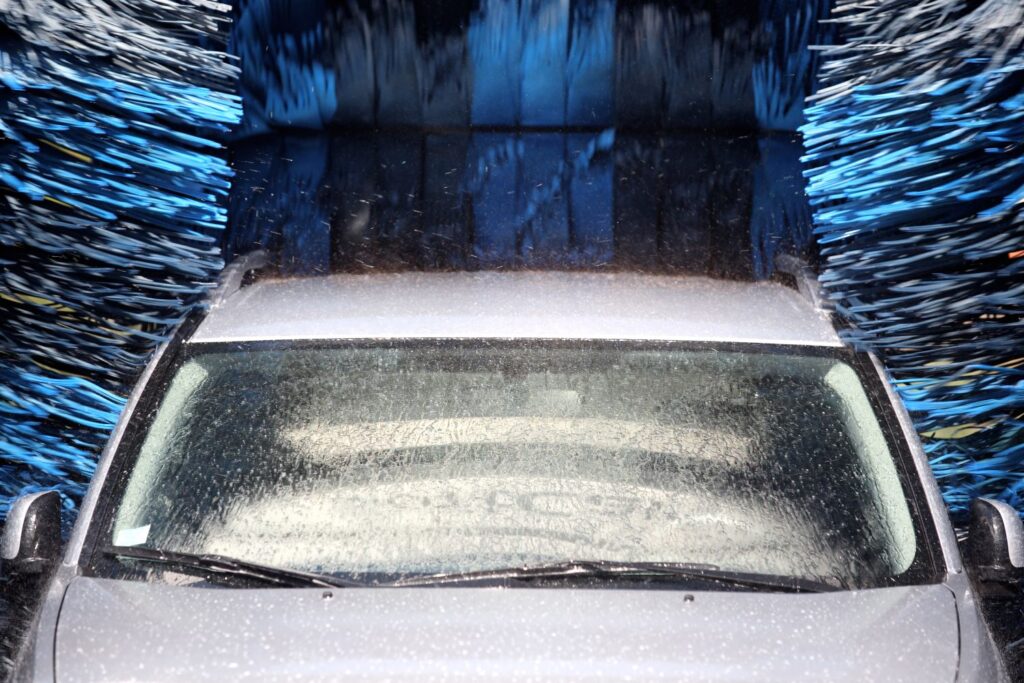A soft-touch car wash uses foamy soap and felt cloth to remove dirt and contaminants from your car’s exterior. Sometimes, soft-touch car washes are called brushless car washes because they don’t use the stiff nylon bristle brushes that are in old automated car washes.
Benefits of Soft-Touch Car Washes
Soft-touch automatic car washes scrub your car with mild friction to remove contaminants like bugs, pollen, dirt, and bird droppings. Soft-touch washes also utilize mild soap with a specific pH balance and water to remove the loose contaminants after the scrubbing. The constant flow of soap and water combined with the felt brush effectively removes dirt and grime without excessively exerting friction onto your vehicle’s surface. Following the scrub, low-pressure water is used to rinse the soapy solution.
Soft-touch washes can also remove salt, hard water spots, and road film, which is the thin layer of dirt, oil, and grit that can build up on your car. The soft bristles can also treat hard-to-reach places around your vehicle, such as grilles, rocker panels, and crevices between body panels.

Downsides of Soft-Touch Car Washes
Applying friction on your vehicle’s paint can potentially dull its shine or worsen existing defects like paint chips, scratches, and corrosion. Since soft-touch car washes use friction to clean your vehicle, there’s still a chance that a soft-touch car wash can damage your vehicle’s paint. Stubborn dirt and debris on the surface can be abrasive and scratch your vehicle’s coat if it’s dragged by the felt cloth. This can happen if the felt cloth inside a soft car wash machine isn’t regularly cleaned.

Soft-Touch Car Wash Vs. Touch-free Car Wash
Touch-free or touchless car washes apply a high-alkaline soap solution onto the exterior then it’s left for some time. After this, a low-pH acid is applied. These chemicals flip the polarity of the electro-molecular bond the dirt has made to the surface of the car, which loosens the dirt and makes it easier to remove. Afterward, high-pressure water blasts the particles off the vehicle’s exterior. This can be good if you’re concerned that the automated rollers can scratch your vehicle. However, touch-free car washes have a reputation for not being able to thoroughly clean considerable amounts of contaminants since they rely entirely on soap solution and water pressure. Soft-touch car washes can clean a vehicle more thoroughly since they physically wipe off the dirt and grime. Harsh chemicals can also damage some paint finishes and remove protective coatings like wax.
Given the risks soft-touch car washes pose to a vehicle’s paint, some car manufacturers even state that owners should only utilize touchless car washes. At the end of the day, the car wash method that you go for will depend on your needs. If you recently drove on dirt trails and your vehicle is covered in mud, then it might be better to go for a soft-touch car wash. This way, you can be confident all the dirt is removed even in hard-to-reach areas. However, if you just want to remove the dirt buildup from driving on the highway, then a touch-free car wash might be sufficient.
Any information provided on this Website is for informational purposes only and is not intended to replace consultation with a professional mechanic. The accuracy and timeliness of the information may change from the time of publication.















